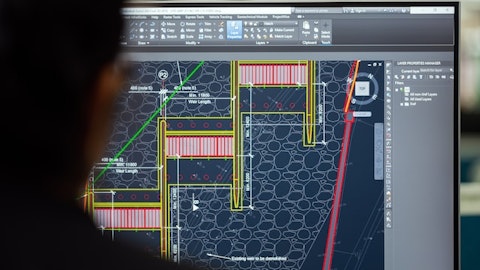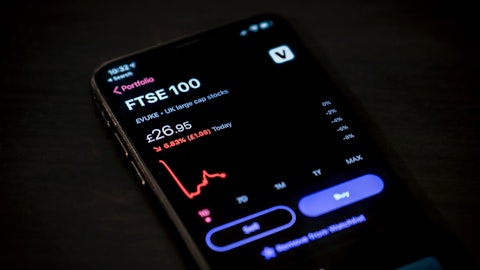EPAM Systems, Inc. (NYSE:EPAM) Q3 2023 Earnings Call Transcript November 2, 2023
EPAM Systems, Inc. beats earnings expectations. Reported EPS is $2.73, expectations were $2.55.
Operator: Hello, and thank you for standing by. My name is Regina and I will be your conference operator today. At this time, I would like to welcome everyone to EPAM’s Third Quarter 2023 Earnings Conference Call. All lines have been placed on mute to prevent any background noise. After the speakers’ remarks there will be a question-and-answer session. [Operator Instructions] I’d now like to turn the conference over to David Straube, Head of Investor Relations. Please go ahead.
David Straube: Thank you, operator, and good morning, everyone. By now you should have received your copy of the earnings release for the company’s third quarter 2023 results. If you have not, copy is available on epam.com in the Investors section. With me on today’s call are Arkadiy Dobkin, CEO and President; and Jason Peterson Chief Financial Officer. I would like to remind those listening that some of the comments made on today’s call may contain forward-looking statements. These statements are subject to risks and uncertainties as described in the company’s earnings release and SEC filings. Additionally all references to reported results that are non-GAAP measures have been reconciled to the comparable GAAP measures and are available in our quarterly earnings materials located in the Investors section of our website. With that said, I’ll now turn the call over to Ark.
Arkadiy Dobkin: Thank you, David, and good morning everyone. Before I get into results of our third quarter, I would like to recap what was certain in regards to our expectations for Q3 and full year outlook three months ago during our last call. We stated that while the current business environment is more focused on cost optimization versus our differentiated build and deploy [Indiscernible]. We do believe the demand for transformation services will come back under the services market. You’ll be moving from core IT to accelerated digitization to reinvent into our business models and ways of working with generative AI as the core of the transformation. And that we expect this new demand to be underpinned and even more driven exactly by our traditionally strong product platform engineering, data analytics and AI ML capabilities.
At the same term, we said we still expect the negative dynamic to continue into second part of 2023. Here is when the outlook begins to normalize. We stated that we are focusing on — towards new experience from very challenging past waters into pragmatic plans and action items, which will be applied to our business throughout the rest of 2023 and into 2024. These changes are transformational for us and already better positioning us in preparation for the return of stronger market demand. That was the first part of our premise. The second critical part was about our efforts to further globalize and stabilize our delivery ecosystem propagate engineering quality standards and optimize operationally our target allocations, while closely focusing on our gross margin improvement efforts.
We also continue throughout the remainder of this year and I expect it to go throughout 2024. So with that reminder, let’s talk about three key topics to address our demand environment, global capabilities and key investments. Demand, we believe that while the demand for the new build for platform application remains lower than historic levels and the impact of ramp-downs in the quarters continue to work through specific client portfolios. Our Q3 results point to sign of stabilization in our business both in new logos and in retail and expanded programs in our existing portfolio, we are seeing signs of renewed interest, particularly in our life science and healthcare verticals also in insurance and energy and not only that. What is important to highlight in today’s business environment, we are putting all possible efforts to address our client current priorities including addressing the mix of engagement models, cost takeouts and consolidation initiatives, while protecting our share of wallet and long-term relationships.
While these factors are leading sometimes to likely lower short-term profitability metrics, we are seeing signs that clients are returning to balance between cost and quality and the pump continues to be well-positioned there. Also it required today an increased focus on demand led sales and go-to-market motions and investments in global partnerships, to win and quickly growing new business. Over the last quarters, our global field organizations and our specialized practice teams are focused on developing new offerings in key verticals and horizontals expand into new engagement models and extending our client portfolio to include new logos across the broader structure of our brands, from large enterprises to mid-market players to new and exciting start-ups in key collaborations.
And more and more often we are engaging with clients at a [indiscernible] of both IT and business functions. One of the examples of those relatively new for us ways to engage is strengthening our partnerships, which have taken on a greater momentum recently with key collaborations driving net new go-to-market propositions, new IP and new client wins. Last quarter, we shared our global partnership with Google Cloud to help our clients fast track the development of artificial intelligence machine learning and data solutions to help them accelerate their transformations into AI-enabled business. Earlier this week, we announced standing strategic collaboration agreement with AWS. This will aim to accelerate modernization adapt cloud-native, architecture and leverage artificial intelligence and advanced analytics to create customer value in key industries such as health care, life science, financial services insurance, energy and gaming.
Furthermore, we expanded our partnership with Microsoft, becoming a globally managed enterprise system integrator. The enhanced partner status and EPAM advanced cloud nature AI and data expertise, will enable us to help our clients modernize transform and simplify complex enterprise platform application and processes, to accelerate business growth powered by Azure OpenAI service. Current results of these efforts are showing up an increasing number of conversations with clients and growing numbers of opportunities. And while it’s still too early to say, when we can show significant result in revenue growth, our production load is starting to come back to the level of comparable result of Q1. And we hope, to see this trend takes shape during the next quarters.
Still, despite signs of improving demand conditions, the global macroeconomic environment remains volatile and we see certain trends reflecting in our own builds notably in Europe, where the contraction in the third quarter is likely to take a few quarters to previous. Now, we are down to global capabilities. India and LatAm for us are key growth delivery regions while Central Eastern Europe and Central Western Asia are areas of stabilization, after our massive allocation efforts. And we’ve seen future growth opportunities. Part of the effort regarding globalization and stabilization of delivery, is the rightsizing and cost optimization across multiple locations based on current and future demand outlook and specific location capabilities seniority of pyramids and office infrastructures.
Some identical efforts are also relevant in several locations in Western Europe and North America. While optimizing some locations, we continue to reinvest in new talent in key initiatives to expand our engineering G&A across all strategic, global delivery locations with continuous harmonization and upskilling efforts, enabled by our own use of AI and EPAM productivity platforms. Those efforts are on the way, as we speak. And we’re already seeing first results and expect to have additional benefits to materialize in 2024. This brings us to the topic of additional investments, which we mentioned in the past multiple times. We are continuously investing in our strategic priorities such as, expansion of differentiated consulting agency data ML AI and cloud capabilities with focus on vertical expertise.
Development of go-to-market with cost-effective solutions, which now include propositions related to use of responsible AI across a broad range of business and technology use cases. Our strong cloud engineering data and ML core services profile should position EPAM to benefit in the medium and long term from the impact of both current pent-up demand for modernization and also from the fundamental skills shortage in concrete technological transformations, which still persist today. The impact will become even more real in terms of complexity of future applications, and platforms by encapsulating not just currently available elements of Gen AI and requirements for trust reliability and security management of AI, but also by closely integrated with new classes of composite and adaptive AI platforms as well as with foundational models and specific industry cloud platforms.
One of the key propositions offered by EPAM is our ability to make real — as part of this focus a number of our labs and centers of excellence have created IP that we are using to productize our learning’s and to share them with our clients through our own open-source initiatives. We mentioned our work with Dial our AI orchestration work bench in our previous call. And today, we see a number of extensions of this platform into specific use cases and specific industries based on real-life problems, which we have addressed with a growing variety of integrated AI tools and data sources. One of our more significant investments related to AI is a development and internal rollout of EPAM responsible AI framework, and a broad in play training to adapt it.
Today, we are confident that EPAM has necessary capabilities and talent to help our clients to evolve in the general adoption of AI, and also in modernization of applications and proper data engineering efforts to drive the value AI promised to bring. Conversations with our clients are evolving as it becomes generally understood that fundamental capabilities and readiness in cloud and medium in data are necessary prerequisites for success. Till the level of interest continues to indicate the demand for our related services will build momentum into 2024 and beyond. I believe that provides a good level of overview of current state and our key areas of focus. To summarize, I would like to say that with the exciting opportunities in front of us.
We are still facing a complete demand environment. We are working to invest for the future while balancing supply and demand for skills and capabilities across a much more diverse delivery footprint. This challenge continues as the war in Ukraine extends into the third year as well as the new disruptions in Middle East escalations require us to continuously adapt the company in appropriate manner. I would think at this point, we feel being well trained to manage all of the them well. So with that, I would like to pass to Jason to share more details and numbers for Q3 and for an update for our business outlook for the remainder of 2023.

Jason Peterson: Thank you, Ark, and good morning everyone. In the third quarter, EPAM generated revenue of over $1.15 billion a year-over-year decrease of 6.1% on a reported basis, or 8% in constant currency terms, reflecting a favorable foreign exchange impact of 190 basis points. Revenue in the quarter continued to be impacted by reduced program spending across a number of our clients, as well as ongoing client cost and related to new project starts. The reduction in Russian customer revenues resulting from our exit from the market had an approximate 50 basis point negative impact on year-over-year revenue growth. Excluding Russia revenues year-over-year revenue for reported a constant currency would have decreased by 5.6% and 7.6% respectively.
Beginning with our industry verticals on a year-over-year basis financial services decreased 3.3% driven by declines predominantly in banking, partially offset by growth in asset management. Consumer decreased by 6.2%, primarily due to declines in consumer goods partially offset by solid growth in travel and hospitality. Life sciences & health care declined 4.2%. The year-over-year growth rate was negatively impacted by the ramp down of a large transformational program in late 2022 which we have mentioned during our previous earnings call. On a sequential basis growth in life sciences & health care was a positive 8.6% and we expect to return to positive year-over-year growth next quarter. Business information & media declined 12% in the quarter.
Revenue in the quarter was impacted by a reduction in spend across a number of large clients based on uncertainty in their end markets particularly in the mortgage data space. Software and Hi-Tech contracted 15.1%. The year-over-year growth rate was negatively impacted by the reduction in revenue from a former top 20 customers we mentioned during our previous earnings calls and generally slower growth in revenue across a range of customers in the vertical. And finally, our emerging verticals delivered solid growth of 8.5% driven by clients in energy, manufacturing and automotive. From a geographic perspective Americas our largest region representing 59% of our Q3 revenues declined 9.3% year-over-year or 9.5% in constant currency. On a sequential basis growth in the Americas was relatively flat an improvement from the declines in previous quarters in 2023.
EMEA representing 39% of our Q3 revenues grew 1.8% year-over-year and decreased 3.5% in constant currency. CEE representing less than 1% of our Q3 revenues contracted 66.4% year-over-year or 58.8% in constant currency. Revenue in the quarter was impacted by EPAM’s exit of its Russian operations. And finally APAC declined 20.2% year-over-year or 19.8% in constant currency terms and now represents 2% of our revenues. Revenue in the quarter was impacted primarily by the ramp down of work within our financial services vertical. In Q3, revenues from our top 20 clients declined 8.3% year-over-year, while revenues from clients outside our top 20 declined 4.9%. Moving down the income statement. Our GAAP gross margin for the quarter was 31.1% compared to 32.6% in Q3 of last year.
Non-GAAP gross margin for the quarter was 32.9% compared to 34.4% for the same quarter last year. Gross margin in Q3 2023 reflects the negative impact of pricing pressure and lower utilization partially offset by a lower level of variable compensation expense. GAAP SG&A was 16.9% of revenue compared to 16.1% in Q3 of last year. Non-GAAP SG&A in Q3 2023 came in at 14.4% of revenue compared to 14.1% in the same period last year. GAAP income from operations was $114 million or 9.9% of revenue in the quarter compared to $180 million or 14.7% of revenue in Q3 of last year. Included in our GAAP results in the quarter is a $25.9 million loss on the sale of the company’s remaining holdings in Russia and $8.4 million in severance as we take steps to reduce our cost structure to better align with demand.
Non-GAAP income from operations was $196 million or 17% of revenue in the quarter compared to $232 million or 18.9% of revenue in Q3 of last year. Our GAAP effective tax rate for the quarter came in at 26.3%, which includes a onetime tax charge connected to the disposal of holdings in Russia and lower-than-expected excess tax benefits related to stock-based compensation. Non-GAAP effective tax rate was 23.2%. Diluted earnings per share on a GAAP basis was $1.65. Our non-GAAP diluted EPS was $2.73, reflecting a $0.37 decrease compared to the same quarter in 2022. In Q3 there were approximately 58.9 million diluted shares outstanding. Turning to our cash flow and balance sheet. Cash flow from operations for Q3 was $215 million compared to $252 million in the same quarter of 2022.
Free cash flow was $211 million compared to free cash flow of $234 million in the same quarter last year. At the end of Q3, DSO was 73 days and compares to 71 days for Q2 2023 and 69 days for the same quarter last year. The uptick in DSO reflects an increase in the time some clients are taking in the review and approval of payments combined with the last day of the quarter falling on a weekend. Share repurchases in the third quarter were approximately 318,000 shares for $78.5 million at an average price of $246.44 per share. As of September 30, we had approximately $372 million of share repurchase authority remaining. We ended the quarter with approximately $1.9 billion in cash and cash equivalents. Moving on to a few operational metrics. We ended Q3 with more than 48,500 consultants, designers, engineers, trainers and architects.
Including the impact of our exit from Russia, production headcount has declined 10% compared to Q3 2022. This is the result of lower levels of hiring combined with both voluntary and involuntary attrition as we continue to balance supply and demand. Our total headcount for the quarter was more than 54,600 employees. Utilization was 72.7% compared to 73.5% in Q3 of last year and 75.1% in Q2 2023. Now, let’s turn to our business outlook. We are encouraged by the results of our demand generation efforts and new customer revenues resulting from these efforts. However, the level of new customer revenues being generated is still not enough to offset the impact from existing project ramp downs and reduced spending from our top 20 clients. We are beginning to see a degree of demand stability emerging in our North American portfolio, but we are also expecting an impact from planned ramp-downs at several of our European customers.
Although, there are encouraging signs, demand remains somewhat uncertain. In addition to the negative impact, the Q4 seasonality usually has on revenue, we’ve also had a large number of employees relocate to countries that celebrate December holidays. In Q4, we were also expecting unfavorable foreign exchange headwinds in comparison with Q3. These factors are producing a sequential decline in Q4 revenue, despite the stabilizing the demand environment. Our Ukrainian delivery organization continues to operate efficiently and our teams remain highly focused on maintaining uninterrupted production. Our guidance assumes that we will continue to deliver from Ukraine at productivity levels consistent with previous levels throughout 2023. During the third quarter, we elevated our focus on aligning our cost structure with the near-term demand environment, initiating a cost optimization program, designed to reduce operating costs by 2.5% to 3%.
This effort is clearly more intentional than our previous supply and demand balancing efforts. We think it is necessary to take this action in part to allow for further investment across our strategic initiatives, demand generation efforts and people programs. As I mentioned earlier, we had $8.4 million in severance-related costs in Q3 of which $7.1 million related to the cost optimization program. In Q4, we expect to recognize a further $15 million in expenses as a result of this cost optimization program. We expect headcount will continue to decline in Q4 due to limited hiring and managed attrition, which will drive utilization slightly higher in the quarter. Moving to our full year outlook. We now expect revenue to be in the range of $4.663 billion to $4.673 billion reflecting a year-over-year decline of approximately 3%.
On an organic constant currency basis excluding the impact of the exit from Russia, we expect revenue to also decline by 3%. We expect GAAP income from operations to now be in the range of 10% to 11% and non-GAAP income from operations to continue to be in the range of 15% to 16%. We expect our GAAP effective tax rate to continue to be approximately 22%. Our non-GAAP effective tax rate, which excludes excess tax benefits related to stock-based compensation is expected to continue to be 23%. Earnings per share, we expect the GAAP diluted EPS will now be in the range of $7.07 to $7.15 for the full year and non-GAAP diluted EPS will now be in the range of $10.31 to $10.39 for the full year. We now expect weighted average share count at 59.1 million fully diluted shares outstanding.
Moving to our Q4 2023 outlook. We expect revenue to be in the range of $1.13 billion to $1.14 billion, producing a year-over-year decline of 8%. On an organic constant currency basis excluding the impact of the exit from Russia, we expect revenue to also decline by approximately 8%. For the fourth quarter, we expect GAAP income operations to be in the range of 10% to 11% and non-GAAP income from operations to be in the range of 15% to 16%. We expect our GAAP effective tax rate to be approximately 24% and our non-GAAP effective tax rate to be approximately 23%. Earnings per share we expect GAAP diluted EPS to be in the range of $1.67 to $1.75 for the quarter and non-GAAP diluted EPS to be in the range of $2.47 to $2.55 for the quarter. We expect a weighted average share count of 58.8 million diluted shares outstanding.
Finally, a few key assumptions that support our GAAP to non-GAAP measurements in the fourth quarter. Stock-based compensation expense is expected to be approximately $36.3 million. Amortization of intangibles is expected to be approximately $5.7 million. The impact of foreign exchange is expected to be minimal. Tax effective non-GAAP adjustments is expected to be around $12 million. We expect excess tax benefits to be around $1.3 million and we expect to recognize approximately $15 million in expenses related to our cost optimization program. In addition to these customary GAAP to non-GAAP adjustments and consistent with the prior quarters in 2023, we expect to have ongoing non-GAAP adjustments in Q4 resulting from Russia’s invasion of Ukraine.
Please see our Q3 earnings release for a detailed reconciliation of our GAAP to non-GAAP guidance. Finally, one more assumption outside of our GAAP to non-GAAP items. With our significant cash position, we are generating a healthy level of interest income and are now expecting interest and other income to be $14 million in the fourth quarter. Looking beyond 2023, we intend to provide our 2024 business outlook during our fourth quarter earnings call scheduled for February. However, I would like to provide some commentary at this time to help frame our initial thoughts. As Ark mentioned, the demand environment remains uneven and we believe this will persist at least into the first half of 2024. We have been pleased with the progress we’re making on demand generation and we’ll continue to prioritize revenue growth into 2024 which in some pursuits include some degree of discounting.
Additionally, in 2024, we expect to incur incremental costs due to more normalized variable compensation as well as salary increases from our annual compensation cycle which typically occurs in Q2. Although the cost optimization program will better align our 2024 cost structure, we still expect wage pressure combined with the limited ability to improve client pricing to continue to put pressure on margins. While 2023 has been a challenging year for the IT sector in EPAM, we remain confident in our ability to drive historical levels of revenue growth and profitability in a more normalized demand environment. Operator let’s open the call up for questions.
See also 20 States That Produce Most Wind Energy and 30 Best School Districts in USA.
Q&A Session
Follow Epam Systems Inc. (NYSE:EPAM)
Follow Epam Systems Inc. (NYSE:EPAM)
Operator: [Operator Instructions] Our first question will come from the line of Bryan Bergin with TD Cowen. Please go ahead.
Bryan Bergin: Hi, good morning guys. Thank you. I guess let’s start on the demand stabilization trends that you highlighted here again. I heard you mentioned production load I think coming back toward 1Q levels. Can you dig in a bit more there? Is that prevalent across industries? And is it consistent across the large client cohort? And just anything how that informs early 2024 client tech budget discussions?
Arkadiy Dobkin: Okay. Let me clarify what we mean. We’re trying to see the trend what’s happening with our production. It’s not about revenue it’s how much work we are doing. Because there are a lot of different parameters which is influenced revenue from FX to number of days to race to discounts and everything else. But from the load point of view, the trend is that we’re seeing we’re coming back to a number of people who are doing production work getting comparable to what we saw in Q1. That’s what it means. It means that, in general, we find end of the way to stabilize our share of the business even with some businesses declining with us but with some new opportunities growing and some actually clients coming back to us. So, from demand environment we have and this is what we mentioned as well.
We’ve seen more conversation about programs more opportunities. But exactly as we mentioned whereas this morning, there is no clear time line of realization of. So, it’s still difficult to say but it seems like pressure on some clients to do work getting bigger. So, well starting to be realized and difficult to say especially with everything geopolitically moving as soon as we see right now. So, more conversations more opportunities to discuss pretty tangible but there is no clear strategy.
Bryan Bergin: Okay. Understood. And then my follow-up on the cost optimization plan. So, Jason what’s the timeframe on achieving that savings target? And can you talk about how you’re balancing efficiency here in the near-term versus global diversification investments for future growth?
Jason Peterson: Yes. So, the program is designed to achieve a somewhat over $100 million or as we talked about in the prepared remarks 2.5% to 3% of our cost structure. Most of the actions will be taken by the end of the year. And then I would say there would be some residual actions that would take place early in 2024 with the idea of giving us effectively $100-plus million in savings to allow us to further invest in 2024. And so that’s in demand generation programs, things like partnership programs, it’s in capabilities, generative AI further consulting. And then it also will allow us to effectively sort of fund a more normalized variable compensation in salary campaign next year. And so again, I expect much of the savings to be achieved by the end of this year and there’ll be probably still some actions taken in Q1.
Truly the costs that we talk about in Q3 and Q4 truly are incremental costs related to either severance payouts in different countries, facilities, lease exits other costs that are incremental and again allow us to achieve a certain amount of savings as we enter 2024.
Bryan Bergin: Thank you.
Operator: Your next question will come from the line of Moshe Katri with Wedbush Securities. Please go ahead.
Moshe Katri: Hey. Thanks. Thanks for taking my question. I want to focus a bit about your selling efforts and using India as one of those I guess the delivery centers to be able to kind of pitch those new engagements. Maybe you can talk about some of your successes here. And on top of that, how does that differ in terms of your ability to generate profitability, compared to what you have pre I guess hostilities in Eastern Europe. Maybe you can talk a bit about that.
Arkadiy Dobkin: So I think as we mentioned multiple times India is growing fast. India is still the investment for us as well from the investment to uplift the capabilities which we have there, because it’s a relatively new location even if it is fastest growing for the last probably three years. So we built in purposely the same type of practices as we have globally from digital engagement to significant data practice and cloud practices. So — and stability question is a difficult one in general in this environment, because the pressure everywhere from any locations which we have. So — but I think we’re seeing definitely opportunity to uplift the market demand coming back. And we are accumulating a lot of experience. Now we have very sizable programs there.
So we also understand that we can hire people and hire them with comparable quality through additional investments which we do there. So I think we’re pretty optimistic about this and with everything that’s happened, as we mentioned several times. I think this will become proportionately much bigger part of EPAM deliveries.
Jason Peterson: Yeah. And I just follow in on the profitability. So as we talked about in the last call and again we’ll continue to talk about here today is that, we continue to have some characteristics with heavier pyramid than we had traditionally operated with the ongoing kind of pressures on pricing and then some amount of wage inflation. And so, it’s hard to sort of return for typical profitability, as we enter the next handful of quarters or maybe through most of 2024. But when we look at India, given some time and particularly more demand we think the ability to sort of run that geography at levels of profitability consistent with what we did in Eastern Europe is certainly possible and more than possible, I’d say likely. So it’s just right now we’re still working through as Ark said, some of the imbalances on pricing and again a heavier delivery pyramid.
Moshe Katri: Understood. And then in that context can you just remind us your headcount mix by Eastern Europe, Latin America and then India where are we today? And where do — what sort of mix do we want to get to down the road?
Jason Peterson: Yeah. So we’re clearly less than 30% in Eastern Europe and heading towards kind of low-20s. India is currently…





